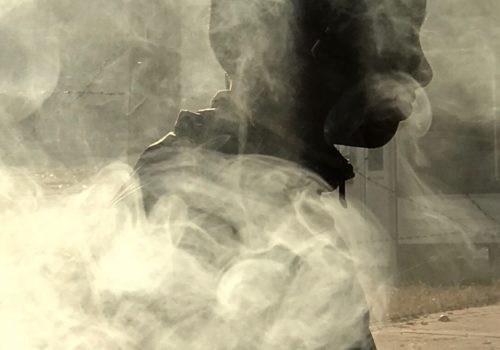Looking for home, for the place where she belongs has come to define the visual language of photographer Laura El-Tantawy. Born in the UK to Egyptian parents, Laura El-Tantawy has spent much of her life between cultures, living in England, and America and holidaying in Egypt. This yo-yoing between such diverse cultures has left her questioning the idea of home and where she may fit, a question that follows her no matter where she rests her head.
This is the subject matter of her latest book Beyond Here is Nothing, an exploration of the idea of home, this intangible concept that we attach to things – to a town, a city, a country, to a house or a flat. Yet the label ‘home’ is also used as a nomenclature for emotions that extend far beyond the idea of where we reside, the physical place where we keep our things. Home can be a person or people, it can be memories or emotions and as such it is an ethereal, almost obscure concept that eludes definition.
El-Tantawy says that living between cultures has, to a certain degree, made her feel “foreign and alien” regardless of which country she is in. “There’s a sense of loneliness that really grows out of that and I think the book has a lot to do with the idea of loneliness. A lot of the images I was taking were through that prism, where I felt completely stuck in that feeling. Many images are taken through windows, some in mirrors, others are reflections, really quiet moments”.
Beyond Here is Nothing follows El-Tantawy’s enormously successful book In The Shadow of the Pyramids another self-published title and a body of work that has been exhibited extensively. Shot in Egypt, Shadows also dealt with concepts of identity, belonging and the defining of home, but with the backdrop of the Arab Spring the visual narrative also reflected the collective hopes and fears of a country.
“With the revolution there was always something to photograph in Egypt,” says El-Tantawy. “But with this new work I really felt like I was photographing the un-photographable…at a moment where I felt like I had something very strong to say and photography was my only mechanism to communicate it.”
Beyond Here is Nothing is a meditative musing that offers an introspective view of El-Tantawy’s psyche and as such it is a very brave, and also inspirational, body of work that presents a compelling, if somewhat abstract narrative.
“Building this body of work was a way for me to cope with all these questions that I had. In that way it is very meditative. Making the work became doing something about that feeling of being stuck…the title has a double meaning too, it’s about reaching a place of perfection where you are completely satisfied or it is about darkness and feeling like you are completely stuck in this one place, that you don’t really know where to go.”
Even the design of the book itself seeks to convey the complexities of trying to define the notion of home by moving the viewer through layers of emotions. Superbly crafted as a three-spine book, it folds open to the left, right and above, so the reader views four images at once. In this format the reader’s first experience of the book is from El-Tantawy’s viewpoint. And that’s what’s so clever about the design. Once she has led you through her emotional journey, which involves pictures and text “which act as punctuation marks,” the viewer has the opportunity to rearrange the pages, to fold the book in a new way, to put the images in a new order, and create a different perspective to experiencing the work.
El-Tantawy explains the thinking behind the design saying, “It’s a book about searching for something that I personally can’t find and I think it’s the same for the viewer. You are peeling through these layers of emotions and you get confused, and lost and you fall in love in some moments, you dream in others and then you reach the end of the book and you think, okay what do I do now? That’s kind of been my state of mind in the last few years and that’s what the book is about, it is trying to reflect on that.”
She concedes that loneliness is not something that “is particularly unique to me,” acknowledging that many feel lonely, but are perhaps uncomfortable speaking about it. “There is a kind of shame in admitting you are lonely, but it’s not a psychoanalytical book in anyway, it is an artistic mediation. I always work from a place of honesty and I think this is going to resonate with people”.
Many of these images were originally posted on El-Tantawy’s Instagram account, but she says the transient nature of online viewing made them feel less real, whereas print has given them life, so to speak. “When I look at an image online usually it is very easily forgettable, and maybe it is because of the number of images I see. They come into my view and then disappear. Having them as a print or in a book gives them staying power, the image confronts you whereas once it disappears on your timeline on Instagram it’s gone, you don’t see it anymore unless you make a conscious effort to find it. What I really love about seeing these images in a book form also is that it brings for me a sense of closure with the work”.
While the subject matter may on the surface sound somewhat grim and depressing, El-Tantawy assures that it is a story about possibilities. “It is uplifting at the end,” she laughs. “But you have to go through the experience, the journey, to arrive at the light”.
Alison Stieven-Taylor
Alison Stieven-Taylor is a writer specializing in photography based in Melbourne, Australia.
Laura El-Tantawy, Beyond Here is Nothing
Self-published edition of 500
Signed and numbered
165€
















